- Joined
- Jan 25, 2015
- Messages
- 2,558
This might seem "noobish" to those that use back gears often, but I've never had need of it before. My TH42 has a Baldor DC motor and a Danfoss speed control:
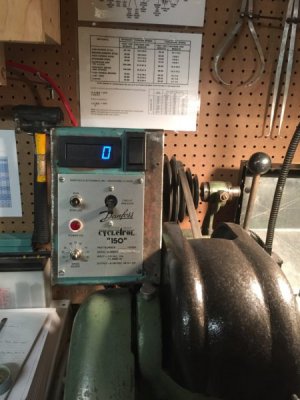
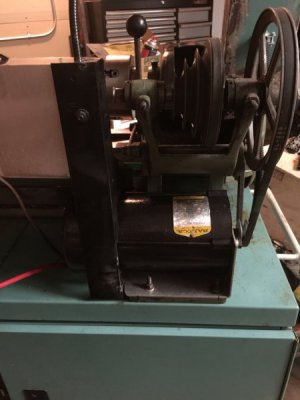
so getting the right rpm/SFPM is just a turn of the dial for me. I almost always work with aluminum, so it's pretty easy to get an acceptable cut with just rpm control.
Well, today I'm dropping a VF750F motorcycle engine in to my 1985 Argo (8x8 amphibious ATV):
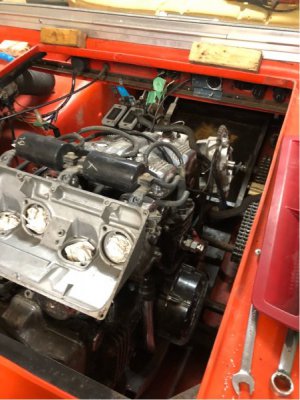
The orginal engine was an 18hp Kohler Magnum, which is an opposed twin cylinder and essentially, a lawn tractor engine.
The Argo has a CVT (think: snowmobile clutch) and the VF is a standard motorcycle hand clutch and gearbox. So I needed a way to go from the VF output shaft to the Argo transmission input shaft (need to keep the Argo transmission for skid steering, reverse gear, etc):
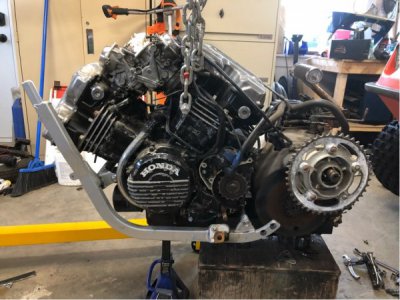
I turned the center hub out of a CBR600RR rear wheel (so I could retain the sprocket carrier and cush drive):
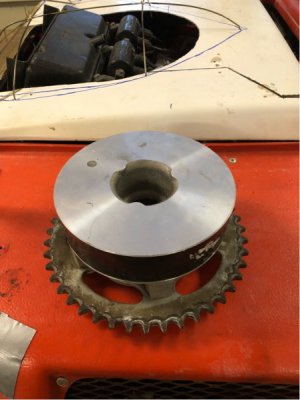
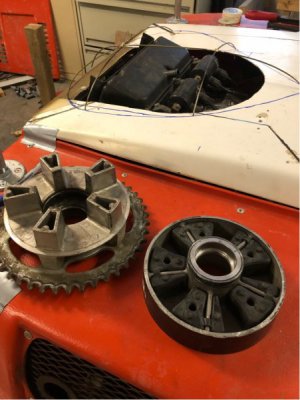
and I'm making a transmission adapter out a 3" round mild steel. The Argo input shaft in 1" OD (with keyway) and the ID of the Hub center is just a bit less than 3".
I chucked up the 3" round stock and tried turning it at the right speed with the Danfoss. Chattering, screaming, burned chips, big rpm drops, stalling, dulling both HSS and Carbide tooling, etc. Just a mess all around. Nothing I try seems to improve any of it. The Baldor is also turning very slowly, which is not a problem for power, but the fan is also turning slowly and it's not getting much cooling air. Not good for any electrical component.
Time to give the back gears a try.
I pull the bull gear pin and engage the back gear lever. The Baldor motor is much happier now. RPM on the motor is up, spindle speed is down nice and low. Witht he moror RPM up, the cooling fan is doing it job as designed. Much easier to make precise adjustments to spindle rpm, which makes it much easier to control SFPM. No more chattering, stalling or grabbing; at 6:1 reduction there's lots of torque. Tooling just glides through the steel now. Where my oil would previously just turn in to smoke, now it actually does it's job. No more brown or blue chips, now it's just nice long curls. RPM now only drops 1 or 2 RPM when the tooling engages the work. Where I had trouble taking a 5 thou cut before, I can now "hog out" a full 20 thou (or 40 thou if you prefer to think of it in diameter vice radius), although it's really much happier at a max of 15 thou and I can finish down to a 1 thou precision.
Its like a completely transformed machine and I can actually work large steel pieces like they were meant to be worked.
Yep, back gears. I think I'll be using them quite a bit more in the future.
PS. Machining isn't my "hobby" (although I do enjoy making things), machining is something I do to support my hobby, which is anything to do with building motorsports stuff. IE: cars, trucks, motorcycles, offroad, airplanes, helicopters, boats, etc. So while this is a "noobish" machining post, it's new knowledge to me.



so getting the right rpm/SFPM is just a turn of the dial for me. I almost always work with aluminum, so it's pretty easy to get an acceptable cut with just rpm control.
Well, today I'm dropping a VF750F motorcycle engine in to my 1985 Argo (8x8 amphibious ATV):

The orginal engine was an 18hp Kohler Magnum, which is an opposed twin cylinder and essentially, a lawn tractor engine.
The Argo has a CVT (think: snowmobile clutch) and the VF is a standard motorcycle hand clutch and gearbox. So I needed a way to go from the VF output shaft to the Argo transmission input shaft (need to keep the Argo transmission for skid steering, reverse gear, etc):

I turned the center hub out of a CBR600RR rear wheel (so I could retain the sprocket carrier and cush drive):


and I'm making a transmission adapter out a 3" round mild steel. The Argo input shaft in 1" OD (with keyway) and the ID of the Hub center is just a bit less than 3".
I chucked up the 3" round stock and tried turning it at the right speed with the Danfoss. Chattering, screaming, burned chips, big rpm drops, stalling, dulling both HSS and Carbide tooling, etc. Just a mess all around. Nothing I try seems to improve any of it. The Baldor is also turning very slowly, which is not a problem for power, but the fan is also turning slowly and it's not getting much cooling air. Not good for any electrical component.
Time to give the back gears a try.
I pull the bull gear pin and engage the back gear lever. The Baldor motor is much happier now. RPM on the motor is up, spindle speed is down nice and low. Witht he moror RPM up, the cooling fan is doing it job as designed. Much easier to make precise adjustments to spindle rpm, which makes it much easier to control SFPM. No more chattering, stalling or grabbing; at 6:1 reduction there's lots of torque. Tooling just glides through the steel now. Where my oil would previously just turn in to smoke, now it actually does it's job. No more brown or blue chips, now it's just nice long curls. RPM now only drops 1 or 2 RPM when the tooling engages the work. Where I had trouble taking a 5 thou cut before, I can now "hog out" a full 20 thou (or 40 thou if you prefer to think of it in diameter vice radius), although it's really much happier at a max of 15 thou and I can finish down to a 1 thou precision.
Its like a completely transformed machine and I can actually work large steel pieces like they were meant to be worked.
Yep, back gears. I think I'll be using them quite a bit more in the future.
PS. Machining isn't my "hobby" (although I do enjoy making things), machining is something I do to support my hobby, which is anything to do with building motorsports stuff. IE: cars, trucks, motorcycles, offroad, airplanes, helicopters, boats, etc. So while this is a "noobish" machining post, it's new knowledge to me.
Last edited:


